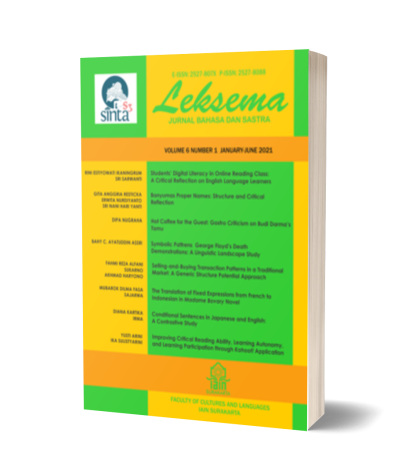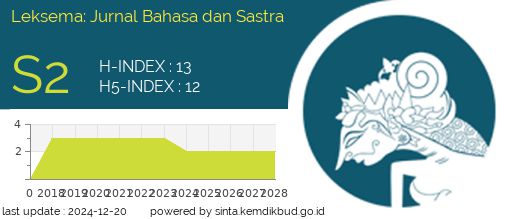CONCEPTUAL METAPHORS IN MAHFUDZAT: THE REPRESENTATION OF KNOWLEDGE VALUES IN ARAB SOCIETY
DOI:
https://doi.org/10.22515/ljbs.v10i1.9009Keywords:
Arab society, conceptual metaphor, knowledge, MahfudzatAbstract
This study aimed to identify the forms of metaphor in Mahfudzat's work on knowledge and to prove that the work reflects the life of Arab society. Lakoff and Johnson's (2003) theory were used as the base for data analysis. The theory states that there are source and target domains in metaphor which are described in this study by using Kovesces' mapping table. As this is a descriptive-qualitative research, the data of this study are in the forms of textual materials of Mahfudzat from Modern Islamic Boarding school Darussalam Gontor. The data source is limited to Mahfudzat materials containing the word ‘knowledge’ in the curricula for Grade 1 and 2. For collecting the data, documentation techniques were applied by reading and understanding the text as well as identifying, classifying, and categorizing the data. Meanwhile, the process of data analysis went through several stages i.e.: reading, composing metaphors, describing conceptual metaphor mapping, categorizing the types of metaphors, and drawing conclusions. The results show that there are 13 data related to science in Mahfudzat. In addition, 8 data containing metaphors were found, comprising 2 structural metaphors, 1 orientational metaphor, and 5 ontological metaphors.
Downloads
References
Alfatih, Muhammad Alif, Arza Aibonotika, and Intan Suri. 2023. “Conceptual Metaphor in Sekai No Owari’s Song”. Jurnal Online Mahasiswa Fakultas Keguruan dan Ilmu Pendidikan Universitas Riau 10 (1): 1–9. https://jom.unri.ac.id/index.php/JOMFKIP/ article/viewFile/34441/33069.
Astri, Nanda Dwi, Margareta Desnawati Naibaho, and Bambang Riyanto. 2023. “Metafora dalam Komunikasi Mahasiswa Pendidikan Bahasa dan Sastra Indonesia FKIP Unpri sebagai Bahan Ajar Apresiasi Sastra”. Journal of Education Research 4 (3): 1308–1314. https://doi.org/10.37985/jer.v4i3.400.
Fatim, Al Lastu Nurul and Abdul Muntaqim Al Anshory. 2023. “Conceptualization of Feminist Metaphors in Social Media Twitter: Cognitive Semantic Analysis”. Kandai 19 (2): 191–203. https://doi.org/10.26499/jk.v19i2.5102.
Haula, Baiq. 2020. “Metafora Konseptual dalam Judul Berita Kontan.co.id: Kajian Linguistik Kognitif”. Suar Betang 15 (1): 15–24. https://doi.org/10.26499/surbet.v15i1.118.
Irwansyah, NFN. 2021. “Metafora Konseptual Cinta dalam Lirik Lagu Taylor Swift di Album 1989.” Suar Betang 16 (1): 49–64. https://doi.org/10.26499/surbet.v16i1.213.
Kövecses, Zoltán. 2010. Metaphor: A Practical Introduction. 2nd Edition. Oxford: Oxford University Press.
Lakoff, George and Mark Johnson. 2003. Metaphors We Live By. Chicago: University of Chicago Press.
Mashud, Mashud, Yuliana Kristianti, and Nita Puspita Sari. 2025. “Metafora Konseptual dalam Wacana Pemilihan Presiden 2024 di Media Kompas.com”. Aksara: Jurnal Ilmiah Pendidikan Bahasa dan Sastra Indonesia 9 (1): 43–51. http://dx.doi.org/10.33087/ aksara.v9i1.1012.
Matanari, Ferri J, Sumardin Zebua, and Ismarini Hutabarat. 2023. “Conceptual Metaphor in Katy Perry’s Song Lyrics.” Jurnal Littera: Fakultas Sastra Darma Agung 2 (1): 33–43. https://doi.org/10.46930/littera.v2i1.3329.
Mufidah, Nurul. 2023. Conceptual Metaphor of English Version Mahfudzot in ‘Mahfudzot Gontor’ Application (Undergraduate Thesis). Malang: UIN Maulana Malik Ibrahim. http://etheses.uin-malang.ac.id/52480/.
Nurkhazanah, Lia Amelia, and Tajudin Nur. 2022. “The Conceptual Metaphor in Korean Poem ‘Indonesia Inmin-Ege Juneun Si [인도네시아]’ by Park Inhwan: Cognitive Semantic Analysis.” Jurnal Kata 6 (2): 241–256. https://doi.org/10.22216/kata.v6i2.884.
Nuryadin, Trian Ramadhan, and Tajudin Nur. 2021. “Metafora Konseptual Bertema Rihlah (Jalan-Jalan) pada Majalah Gontor: Analisis Semantik Kognitif”. Diglosia: Jurnal Kajian Bahasa, Sastra, dan Pengajarannya 4 (1): 91–100. https://doi.org/10.30872/ diglosia.v4i1.72.
Risthavania Putri, Siva, Nadiya Yunianti, and Neneng Nurjanah. 2023. “Metafora Konseptual pada Lirik Lagu Karya Fiersa Besari dan Feby Putri”. Jurnal Ilmiah Semantika 5 (1): 40–48. https://doi.org/10.46772/semantika.v5i01.1146.
Schleifer, S Abdallah, Tarek Elgawhary, and Aftab Ahmed (eds.). 2023. The Muslim 500: The World’s 500 Most Influential Muslims, 2024. Amman: The Royal Islamic Strategic Studies Centre. https://themuslim500.com/wp-content/uploads/2023/10/The-Muslim-500-2024-Free.pdf.
Tahir, Gustia. 2015. “Sinergitas Ilmu dan Adab dalam Perspektif Islam”. Jurnal Adabiyah: The Journal of Islamic Humanities. https://journal.uin-alauddin.ac.id/index.php/adabiyah/ article/view/689/pdf_39.
Trisiana, Dinda, Velayeti Nurfitriana Ansas, and Arif Husein Lubis. 2024. “Analisis Metafora Konseptual dalam Puisi Indonesia dan Korea karya Chairil Anwar dan Seo Jeong-ju”. Diglosia: Jurnal Kajian Bahasa, Sastra, dan Pengajarannya 7 (3): 465–476. https://doi.org/10.30872/diglosia.v7i3.1001.
Wangi, Baiq Larre Ginggit Sekar, Nahdlatuzzainiyah Nahdlatuzzainiyah, and I Wayan Kusuma Di Biagi. 2025. “Analisis Pragmatik Metafora dalam Kumpulan Puisi K.H. Mustofa Bisri”. Journal of Linguistics and Language Teaching 1 (1): 30–35. https://doi.org/10.71094/jollt.v1i1.54.
Widiasri, Fathiyyah Sekar, and Tajudin Nur. 2021. “Metafora Konseptual dalam Rubrik Teknologi Koran Elektronik Kompas”. Kajian Linguistik dan Sastra 5 (2): 137–144. https://doi.org/10.23917/kls.v5i2.11057.
Widyastuti, Indah Putri, and Nur Fateah. 2024. “Metafora Konseptual Percintaan dalam Lagu Didi Kempot Berjudul Banyu Langit Album Kasmaran”. Belantika Pendidikan 7 (1): 29–37. https://doi.org/10.47213/bp.v7i1.360.
Downloads
Published
Issue
Section
License
Copyright (c) 2025 Leksema: Jurnal Bahasa dan Sastra

This work is licensed under a Creative Commons Attribution-NonCommercial-ShareAlike 4.0 International License.
The copyright of the received article shall be assigned to the publisher of the journal. The intended copyright includes the right to publish the article in various forms (including reprints). The journal maintains the publishing rights to published articles.
In line with the license, the authors and users (readers or other researchers) are allowed to share and adapt the material only for non-commercial purposes. In addition, the material must be given appropriate credit, provided with a link to the license, and indicated if changes were made. If authors remix, transform or build upon the material, authors must distribute their contributions under the same license as the original.






